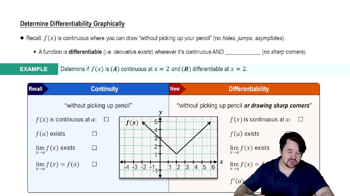Reproduce the graph of f and then plot a graph of f' on the same axes. <IMAGE>
Table of contents
- 0. Functions7h 52m
- Introduction to Functions16m
- Piecewise Functions10m
- Properties of Functions9m
- Common Functions1h 8m
- Transformations5m
- Combining Functions27m
- Exponent rules32m
- Exponential Functions28m
- Logarithmic Functions24m
- Properties of Logarithms34m
- Exponential & Logarithmic Equations35m
- Introduction to Trigonometric Functions38m
- Graphs of Trigonometric Functions44m
- Trigonometric Identities47m
- Inverse Trigonometric Functions48m
- 1. Limits and Continuity2h 2m
- 2. Intro to Derivatives1h 33m
- 3. Techniques of Differentiation3h 18m
- 4. Applications of Derivatives2h 38m
- 5. Graphical Applications of Derivatives6h 2m
- 6. Derivatives of Inverse, Exponential, & Logarithmic Functions2h 37m
- 7. Antiderivatives & Indefinite Integrals1h 26m
- 8. Definite Integrals4h 44m
- 9. Graphical Applications of Integrals2h 27m
- 10. Physics Applications of Integrals 2h 22m
2. Intro to Derivatives
Basic Graphing of the Derivative
Problem 55aBriggs - 3rd Edition
Textbook Question
A capacitor is a device in an electrical circuit that stores charge. In one particular circuit, the charge on the capacitor Q varies in time as shown in the figure. <IMAGE>
a. At what time is the rate of change of the charge Q' the greatest?
 Verified step by step guidance
Verified step by step guidance1
Step 1: Understand that the rate of change of the charge Q with respect to time is represented by the derivative Q'(t). We are looking for the time at which this derivative is the greatest.
Step 2: Analyze the graph of Q(t) provided in the image. The rate of change, Q'(t), is represented by the slope of the tangent line to the curve at any point.
Step 3: Identify the point on the graph where the slope of the tangent line is steepest. This point corresponds to the maximum value of Q'(t).
Step 4: If the graph is not available, consider the mathematical function Q(t) if provided. Take the derivative of Q(t) to find Q'(t) and determine where this derivative reaches its maximum value.
Step 5: Verify the time at which Q'(t) is greatest by checking the concavity of Q(t) around this point, ensuring it is indeed a maximum.
 Verified video answer for a similar problem:
Verified video answer for a similar problem:This video solution was recommended by our tutors as helpful for the problem above
Video duration:
2mPlay a video:
Was this helpful?
Key Concepts
Here are the essential concepts you must grasp in order to answer the question correctly.
Rate of Change
The rate of change refers to how a quantity changes over time, often represented mathematically as a derivative. In the context of the capacitor's charge Q, the rate of change Q' indicates how quickly the charge is increasing or decreasing at any given moment. Understanding this concept is crucial for determining when the charge is changing most rapidly.
Recommended video:

Intro To Related Rates
Derivatives
Derivatives are fundamental tools in calculus that measure how a function changes as its input changes. For the charge Q as a function of time, the derivative Q' provides insight into the instantaneous rate of change of charge. Analyzing the derivative helps identify critical points where the rate of change reaches its maximum.
Recommended video:

Derivatives
Graphical Analysis
Graphical analysis involves interpreting the visual representation of a function to understand its behavior. In this case, examining the graph of charge Q over time can reveal where the slope (representing Q') is steepest, indicating the greatest rate of change. This method is essential for visually identifying key points in the function's behavior.
Recommended video:

Determining Differentiability Graphically

 6:15m
6:15mWatch next
Master Graphing The Derivative with a bite sized video explanation from Nick
Start learningRelated Videos
Related Practice
Textbook Question
12
views
